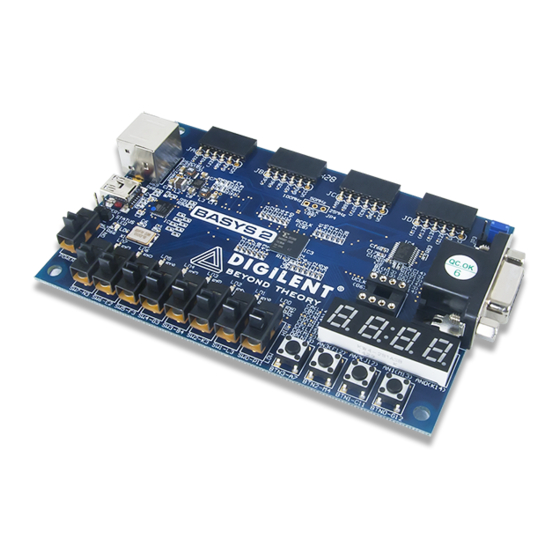Digilent Basys 2 Podręcznik referencyjny - Strona 8
Przeglądaj online lub pobierz pdf Podręcznik referencyjny dla Sprzęt komputerowy Digilent Basys 2. Digilent Basys 2 12 stron. Fpga board

Basys2™ FPGA Board Reference Manual
6
VGA Port
The Basys 2 board uses 10 FPGA signals to create a VGA port with 8-bit color and the two standard sync signals (HS
– Horizontal Sync, and VS – Vertical Sync). The color signals use resistor-divider circuits that work in conjunction
with the 75-ohm termination resistance of the VGA display to create eight signal levels on the red and green VGA
signals, and four on blue (the human eye is less sensitive to blue levels). This circuit, shown in figure 13, produces
video color signals that proceed in equal increments between 0V (fully off) and 0.7V (fully on). A video controller
circuit must be created in the FPGA to drive the sync and color signals with the correct timing in order to produce a
working display system.
6.2
VGA System Timing
VGA signal timings are specified, published, copyrighted and sold by the VESA organization (www.vesa.org). The
following VGA system timing information is provided as an example of how a VGA monitor might be driven in 640
by 480 mode. For more precise information, or for information on other VGA frequencies, refer to documentation
available at the VESA website.
CRT-based VGA displays use amplitude-modulated moving electron beams (or cathode rays) to display information
on a phosphor-coated screen. LCD displays use an array of switches that can impose a voltage across a small
amount of liquid crystal, thereby changing light permittivity through the crystal on a pixel-by-pixel basis. Although
the following description is limited to CRT displays, LCD displays have evolved to use the same signal timings as
CRT displays (so the "signals" discussion below pertains
to both CRTs and LCDs). Color CRT displays use three
electron beams (one for red, one for blue, and one for
green) to energize the phosphor that coats the inner
side of the display end of a cathode ray tube (see
illustration). Electron beams emanate from "electron
guns" which are finely-pointed heated cathodes placed
in close proximity to a positively charged annular plate
called a "grid". The electrostatic force imposed by the
grid pulls rays of energized electrons from the
cathodes, and those rays are fed by the current that
flows into the cathodes. These particle rays are initially
accelerated towards the grid, but they soon fall under
the influence of the much larger electrostatic force
that results from the entire phosphor-coated display
surface of the CRT being charged to 20kV (or more).
The rays are focused to a fine beam as they pass
through the center of the grids, and then they accelerate to impact on the phosphor-coated display surface. The
phosphor surface glows brightly at the impact point, and it continues to glow for several hundred microseconds
after the beam is removed. The larger the current fed into the cathode, the brighter the phosphor will glow.
Between the grid and the display surface, the beam passes through the neck of the CRT where two coils of wire
produce orthogonal electromagnetic fields. Because cathode rays are composed of charged particles (electrons),
they can be deflected by these magnetic fields. Current waveforms are passed through the coils to produce
magnetic fields that interact with the cathode rays and cause them to transverse the display surface in a "raster"
pattern, horizontally from left to right and vertically from top to bottom. As the cathode ray moves over the
surface of the display, the current sent to the electron guns can be increased or decreased to change the
brightness of the display at the cathode ray impact point.
Copyright Digilent, Inc. All rights reserved.
Other product and company names mentioned may be trademarks of their respective owners.
Anode (entire screen)
Cathode ray tube
Deflection coils
Cathode ray
High voltage
deflection
supply (>20kV)
control
control
Figure 14. CRT deflection system
Electron guns
Grid
(Red, Blue, Green)
R,G,B signals
(to guns)
grid
gun
control
Page 8 of 12
VGA
cable
